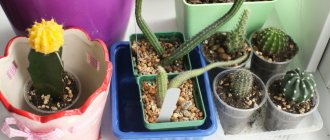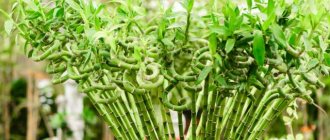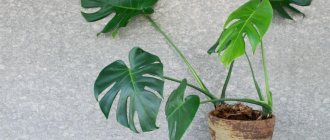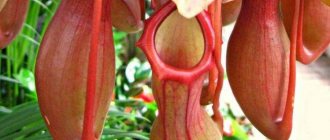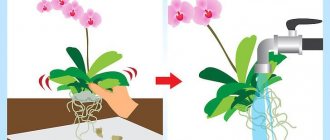Monstera is a large evergreen vine from the Araceae family. Its homeland is the equatorial regions of South and Central America: Panama, Brazil, Mexico, Guatemala, Costa Rica.
The plant has a thick climbing stem with aerial roots. Young leaves on long petioles are whole and leathery to the touch. Then slots and holes of different shapes and sizes appear on them. The color of the leaf blade is dark green, there are varieties with variegated foliage. The inflorescence is a large spadix surrounded by a spathe. Rarely blooms.
In indoor conditions, Monstera grows up to 2-4 meters, and can reach such height in 4-5 years. It produces 2-3 sheets per year. Life expectancy is 10 years or more.
| It produces 2-3 sheets per year. |
| The inflorescence is a large spadix surrounded by a spathe. Rarely blooms. |
| The plant is grown with little difficulty. |
| Perennial. 10 years or more. |
2.Description - what the plant looks like
A small genus of perennial evergreen vines that contains about 20 plant species.
The monstera flower is a very large and spectacular epiphytic plant that has well-developed, long, straight aerial roots, with which it clings to the support.
The roots of the vine are located not only in the soil - the plant has long aerial roots hanging from the trunk and also saturating the plants with moisture and nutrients. Aerial roots appear at leaf nodes opposite the leaf blades.
The leaves are dark green, glossy, round, up to 45 cm in diameter, located on long petioles - up to 30 cm, young leaves are whole, large leaves become carved. The newly emerged leaves are rolled into a tight tube and have a lighter, green tint. Carved leaves are necessary for the plant so that droplets of moisture can freely penetrate through them to the root system.
During the flowering period, the monstera throws out an inflorescence - an ear up to 25 cm long, surrounded by a white blanket. The flowering plant Monstera can rarely be found in indoor culture.
Photo: zoosnow
Ripe fruits are oblong and light green, edible and pleasant to the taste - reminiscent of pineapple, but they take almost a year to ripen.
In general, Monstera is a very beautiful vine and perhaps it got its name “monstera” or “monster” due to its gigantic size. There is another version - the plant was called monstera for its large, carved leaves.
↑ Up,
Photo: Forest and Kim Starr
Height . When grown in a home culture, indoor monstera can reach a height of 3 - 4.5 m, it grows quickly and gains up to 1.5 m in height over the season.
↑ Up,
Photo: Mokkie
Common problems
Indoor monstera is generally resistant to diseases and pests. All problems are related to violation of content rules. Let's list the main ones.
- The leaves turn brown and dry out at the edges. Cause: dehydration or salt accumulation. Replace the substrate, adjust the frequency of watering.
- Drooping stems, limp leaves: lack of water, dry air. To stop wilting, increase the amount of watering. Do not forget to spray the seedling daily.
- Leaves turn yellow: lack of microelements. Choose the right fertilizer. Increase the amount of fertilizing.
- A blackened trunk indicates the occurrence of root rot. The cause of the disease is excess moisture. Replace the soil. Treat monstera roots with any systemic preparation. And remember, the drainage layer in the pot should not be less than 3 cm!
3. Reproduction of monstera
Monstera is often propagated by cuttings .
Stem or apical cuttings are rooted in a moist mixture of peat and coarse sand in spring and early summer.
- Part of the stem is cut off with a sharp sterile instrument just below the leaf node (the cut should be oblique), and the cut site on the mother plant is treated with finely crushed charcoal. A hacksaw is sometimes required to separate cuttings from large mature plants.
- The base of the cuttings is dusted with growth hormones.
- The lower leaves are removed from the cuttings.
- Rooting is carried out under a glass or plastic cover for 1.5 months. Cuttings can be rooted even in plain water without the use of growth hormones, and roots appear much faster in opaque containers. The first roots can be seen within 3 - 4 weeks.
- Such specimens are planted in the ground when the roots reach a length of about 5 cm.
↑ Up,
For planting, select a pot that is not too large - after all, the flower will grow green mass only when it has mastered the space of the pot with its root system.
Plants rooted in water are slightly slowed down in their development - their root system gradually adapts to new conditions.
When rooting in the ground, the appearance of new growth will be a sign of the success of the process.
↑ Up,
Reproduction by air layering:
- Find a leaf with an aerial root located below it.
- Just below the root, make an incision with a sharp, sterile instrument, about a third of the diameter of the trunk.
- Wrap the base of the leaf, the aerial root and the cut with a thick - about 3 cm layer of damp sphagnum moss and cover with plastic wrap so that the moss does not dry out.
- Moisten the sphagnum moisturize with a syringe with a needle, injecting water directly through the polyethylene.
After some time, roots will appear in this place - then the cutting can be separated from the mother plant and planted separately. Remember that young plants should be placed in a warm place without direct sunlight.
↑ Up,
Photo: KarlDarcie
By seeds - germination of fresh seeds can occur within a few weeks. Young monsteras develop relatively slowly.
Over time, seeds quickly lose their viability, so only fresh material is used for propagation.
↑ Up,
Air temperature
Since Monstera in natural conditions is an inhabitant of the equatorial part of Central and South America, it requires similar conditions at home. The plant feels comfortable when the thermometer readings are from 25 to 28 °C in summer, and from 16 to 18 °C in winter. Moreover, if in the hot season the temperature rises above 27°C, you need to take care of increasing the humidity and increasing the frequency of watering. And in winter, when the temperature drops below 16°C, the frequency of watering must be reduced. Monstera does not like drafts and sudden temperature fluctuations.
4.When it blooms
Monstera rarely blooms indoors.
For flowering to occur, it is necessary to place the plant in a brightly lit place without direct sunlight, regularly water and spray the vine to create a climate reminiscent of the plant’s homeland.
Young monsteras are able to bloom in the second year.
↑ Up,
What flower arrangements can be made?
Monstera can live in the same pot with other plants. Philodendron or scindapsus are added to it.
Pots with monstera and other foliage plants are often combined into one ensemble:
- dracaena;
- yucca;
- ficus;
- chlorophytum.
Of the succulents, place a money tree or a Decembrist next to the monstera. You can complement the composition with a pike tail.
5.Home care
5.1.How to transplant a monstera
Young plants are replanted in the spring , annually , changing the pot size to a larger one.
Large older specimens need replanting approximately every 2 - 3 years .
Replanting mature plants is difficult due to their size, so replace the top layer of soil with fresh one every year.
The decorative monstera loves spacious containers - plants slow down their development in modest pots. Each time, offer the plant a pot slightly larger in volume than the previous one.
↑ Up,
To plant large species, you should select a very heavy, stable container or even a wooden tub - after all, this huge plant can tip over under its own weight.
- When replanting, inspect the root system - damaged and rotten roots should be trimmed with a sharp, sterile instrument and sprinkled with crushed charcoal.
- You should definitely put a good drainage layer on the bottom of the pot.
- When planting, maintain the same depth as the plant was in the previous pot.
- You should immediately take care of installing a support for this vine in the center of the pot.
- Aerial roots , so that they do not interfere with the transplantation process, are tightly attached to the plant trunk or to a support. If such roots are located not high above the surface of the ground, then they should be buried.
- When planting, the soil around the plant is compacted to remove air pockets.
- After replanting, the monstera is watered abundantly to completely saturate the soil with water; if the substrate has settled too much, a new soil mixture is added.
Only transplanted plants are placed away from direct sunlight.
Instead of replanting, you can use gentle transshipment - transferring the plant to new soil along with a lump of earth.
↑ Up,
5.2. Land for monstera
Compost should be well-drained and nutritious.
A mixture of garden soil with peat, leaf humus, turf and humus components is suitable for keeping indoor flowers. Add coarse river sand or vermiculite and perlite to improve drainage. It will be useful to add charcoal in a small amount - this will loosen the soil and add useful minerals.
The soil should have a neutral or slightly acidic pH. Monstera loves a very loose substrate, which will allow moisture and air to pass to the roots of the plant.
↑ Up,
5.3.Growing and pruning monstera
How to grow monstera at home? Caring for the plant is not difficult, but over time the flower will require quite a lot of free space.
Monstera stems often need support - use a large pole braided with moss or coconut fiber as a support for plants - the monstera will conveniently cling to it with its aerial roots.
Monstera develops quickly and fills all available space, so large varieties often need pruning . To maintain a neat appearance, its stems can be trimmed in the warm season . Trimming the top of the vine will promote the growth of side shoots.
Regularly remove old and yellowed leaves to keep your plants looking neat and attractive.
Wipe the leaves periodically with a damp sponge to remove dust.
The aerial roots of the plant that reach the surface of the substrate should be sprinkled with soil if possible - they will additionally nourish the vine. If the roots are hard and become unmanageable, wrap them with cling film along with the trunk - after a while they will become soft and pliable.
↑ Up,
If possible, turn the container with the plant every 2 weeks a quarter turn so that the leaves do not lean towards the light source.
The petioles of the leaves are brittle, so you should not place the plant in corridors; when placed near heating devices, the monstera may suffer from dry air.
The liana will grow well in the fresh air in the warm season under cover from direct rays of the sun and rain - however, the plant should be accustomed to any changes in its maintenance gradually.
↑ Up,
5.4.Growing temperature
This heat-loving houseplant prefers to be kept at normal room temperature throughout the year - the plant appreciates being kept warm during the growing season - for example, at a temperature of 22 to 30 ° C.
As the temperature rises, the air humidity should also increase.
When the temperature drops below 18° C, the monstera slows down or even stops its growth. Monstera tolerates temperature fluctuations well, but do not expose it to temperatures below 13 ° C.
↑ Up,
5.5.Spraying
When the temperature rises above 22° C, the air humidity should also be increased by spraying the leaves of the plant or placing it on a tray with wet pebbles or sphagnum moss.
Spraying should be carried out in the morning so that the moisture evaporates before dusk. Do not spray plants that are in direct sunlight - burns may appear on the leaves. For spraying, you must use only softened water at room temperature - in this case, there will be no whitish streaks or spots left on the dark green glossy leaves. If the flower is grown on a support braided with sphagnum or coconut fiber, you can spray the support itself.
To increase air humidity, you can place a room humidifier or simply form a garden of several plants in one place - they will together increase the air humidity.
Monstera loves warm showers with temperatures around 40°C in the summer months.
The plant does not like cold drafts , but welcomes good air movement - do not place the indoor flower under the air conditioner.
↑ Up,
5.6.Water Monstera
Watering should be plentiful - until the substrate is completely soaked, but the soil should dry to 1/3 of the depth or to a depth of 5 - 6 cm for tub plants before each next watering.
During cool wintering, the frequency of watering is significantly reduced and the plant is kept in almost dry soil. Be sure to drain excess moisture that appears in the pan after watering. The frequency of watering will depend on the temperature and humidity in the room.
For irrigation, use only well-settled or even filtered water at room temperature.
↑ Up,
5.7.Lighting
Well lit location.
It is necessary to shade from direct rays of the sun in summer and spring , during the daytime. In the morning and evening, plants can take sunbaths.
In autumn and winter, when the sun is often hidden by clouds, the plant should be provided with the maximum possible lighting.
Monstera stops growing in deep shade, and its leaves will not be as delicate as those of vines grown in the light, so you should not place the flower near northern windows . Eastern and western windows are considered the most suitable for growing . When placed on the south side, it is enough to move the plant slightly deeper into the room or slightly shade it with a curtain.
Variegated plants require more sun - when grown in partial shade, their leaves may turn simply green.
↑ Up,
5.8.Feeding
Feed with liquid complex fertilizers for ornamental foliage plants every two weeks during the growing season. For fertilizing, fertilizers containing equal amounts of nitrogen, phosphorus and potassium are used. The liana reacts positively to organic fertilizers .
If the plant is kept cool during the winter months, fertilizing should be stopped until new growth begins in the spring.
Since in its natural habitat the monstera behaves like an epiphytic plant, foliar feeding - when the nutrient solution is applied directly to the leaves using a spray bottle.
↑ Up,
Watering, fertilizer
Caring for vines at home is not difficult. The plant does not require frequent watering, although it is moisture-loving. Monstera leaves are covered with a waxy coating and evaporate little moisture. Watering is carried out after the soil has dried from above, preferably with warm water.
Young plants do not need fertilizing, but adults need organic and mineral fertilizers 2 times a month during the warm seasons of the year.
Flower shops have a wide selection of fertilizers. For example, “Agricola 7”, “Nitrophoska”, “Lingogumat” and others. Before use, you should read the instructions.
8.Note
Monstera contains toxins in all parts of the plant, so be careful when handling it. Keep Monstera away from children and pets.
The sap of the plant can cause contact dermatitis.
When ingested, poisoning occurs, the symptoms of which are burning of the mucous membranes, esophagus and stomach, excessive salivation, and the formation of blisters at the points of contact of the mucous membranes with the juice of the plant.
The fruits of Monstera deliciosa are considered edible, but they can only be eaten when fully ripe, since unripe ones contain juice that irritates the mucous membranes.
↑ Up,
Monstera is able to purify indoor air from harmful substances such as formaldehyde, adds oxygen to the room atmosphere and increases air humidity.
Plants grow indoors for many years with proper care.
Monstera “cries” when there is a sudden change in air pressure, especially if it is in a room with high humidity. Condensation settles on large plant leaves and droplets of moisture roll down to the edges of the leaf blades.
↑ Up,
Is it possible to keep at home (benefits and harms of the plant)
Thanks to its huge leaves, Monstera is able to fill the air with oxygen. But, on the contrary, it absorbs it when the process of photosynthesis stops.
Therefore, it is not recommended to keep the monstera in the bedroom if it is poorly ventilated. This reduces the quality of sleep.
It is believed that the giant vine has a good effect on the microclimate, purifies the air of formaldehyde, and has a positive effect on the immune system.
There is an opinion that this plant is a “mozhegon”. And the woman in whose house it settled will soon get divorced. But similar superstitions surround many house flowers.
Esotericists believe that monstera helps to concentrate and increases a person’s intellectual abilities.
The leaves of the plant contain needle-shaped crystals of oxalic acid lime.
Contact of this substance with mucous membranes causes poisoning. Its symptoms are swelling and tissue numbness.
Although this condition is usually not life-threatening, Monstera should be kept out of their reach in a home with pets and small children.
10.Types of monstera - photos and names:
10.1. Delicious or attractive monstera - Monstera deliciosa
The most common cultivated and easily recognizable species, the plants initially produce solid, green, heart-shaped leaves with a glossy surface, but with age the leaf blades become carved. This species has long light brown roots hanging from the trunk. In the natural environment, these roots serve the plant to attach to tree trunks. Another, outdated name for this species is Philodendron perforatum.
↑ Up,
Photo: Joanna Pędzich-Opioła
10.2. Monstera variegated, marbled or spotted - Monstera Variegated
Very showy varieties with beautiful, carved dark green leaves with white spots and stripes can be found among all monstera subspecies. All leaves on the plant have different colors from combinations of white, light green and green tones. The white parts of the leaf do not contain chlorophyll, and therefore, to maintain an attractive appearance, this plant should be placed in a bright room. When grown in partial shade, the leaves will be green. All varieties of monstera can be variegated.
↑ Up,
10.3. Monstera oblique or unequal - Monstera Obliqua
The miniature monstera, reaching a height of 1 m, is rarely found on sale. Often the leaves of this monstera are not cut to the edges of the leaf blades, but have oblong-oval holes. The leaf blades are thin, hard, lacy, often leaving only small areas near the veins. This species often loses its attractiveness with age - the plants stretch out and lose some of the leaves - periodically replace old specimens with new plants obtained using cuttings.
↑ Up,
For those who love this plant, but are afraid to get one because of its large size, there are mini-monsteras, the leaves of which often do not exceed 5 cm in length.
10.4.Monstera friedrichsthalii, Monstera adansonii
A giant evergreen herbaceous vine, the stems of which can reach 10 - 20 m in length, develops more slowly than other monsteras. The leaves are green, lanceolate, on long, straight petioles, reaching 65 cm, and have oblong, oval holes.
↑ Up,
10.5. Monstera pierced or full of holes - Monstera pertusa
An evergreen vine with green, flexible shoots. At the leaf nodes, the stems form aerial roots. The leaves are green, glossy, on long petioles, palmately cut.
↑ Up,
What diseases and pests affect the plant?
The most common monstera disease is root rot. It develops due to waterlogging of the soil as a result of overwatering, most often in autumn and winter.
Signs of root rot - the trunk of the plant softens, the leaves turn yellow and droop, and subsequently fall off.
The liana is replanted, damaged roots are removed, and the remaining ones are disinfected with a solution of potassium permanganate.
Fusarium also affects Monstera roots:
- the reason is excessive watering;
- signs - yellowing leaves, thinning stem;
- there is no treatment.
Late blight occurs due to the use of dirty tools or contaminated soil. Symptoms are brown spots and white plaque. Treatment is carried out using fungicides.
Chlorosis occurs due to watering with poorly settled water containing chlorine. Signs are first yellowing, then pale, thinning leaves. Treatment is carried out using iron chelate.
Anthracnose is recognized by yellow-brown spots on the leaves. The plant is sprayed with a product containing copper.
Monstera pests and methods of controlling them are listed in the table.
| Insect | Signs of defeat | Recommended drug |
| Shchitovka | The leaves turn yellow and fall off. Black bumps are visible on the plates | Aktara, Biotlin |
| Spider mite | The leaves are turning yellow. A cobweb appears | Fitoverm, Akarin, Actellik |
| Mealybug | White coating on the leaves. Leaves become deformed and fall off | Soap solution, Fitoverm, Actellik |
| Thrips | Leaves have turned gray or brown | Aktara, Iskra, Biotlin |
If the monstera is attacked by pests, then before using the drugs, they must be removed as much as possible. The plant is either bathed in the shower, or, if it is too large, wiped.
When affected by spider mites and thrips, in addition to treatment, the air humidity should be increased.
Growing difficulties
When growing monstera, you may encounter the following problems:
- drying, yellowing and darkening leaves - excessively dry and hot air in the room;
- drilling and cracks on the leaves - the room is too cold and damp;
- small, pale and without slits leaves - lack of lighting;
- stem rotting - low temperature and excessive watering;
- dark spots on the inner surface of the leaves - damage by red spider mites;
- flaccid and “crying” leaves - excess moisture in the soil and atmosphere;
- yellowing and small leaves, but without wilting - a deficiency of nutrients in the soil;
- pale leaves with yellow spots - prolonged exposure to direct sunlight.
The main methods of combating all these phenomena is to eliminate errors in the care and maintenance of vines.
Many experienced gardeners believe that growing monstera is not a difficult task even for novice plant lovers. As a result of the work, you will get an exotic tropical corner, in the shade of which it will be pleasant to relax and admire the unusual leaves of a luxurious green beauty.




